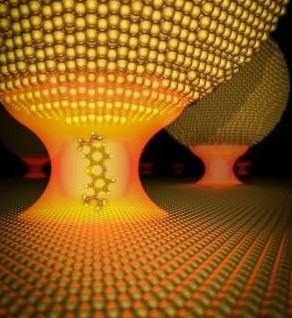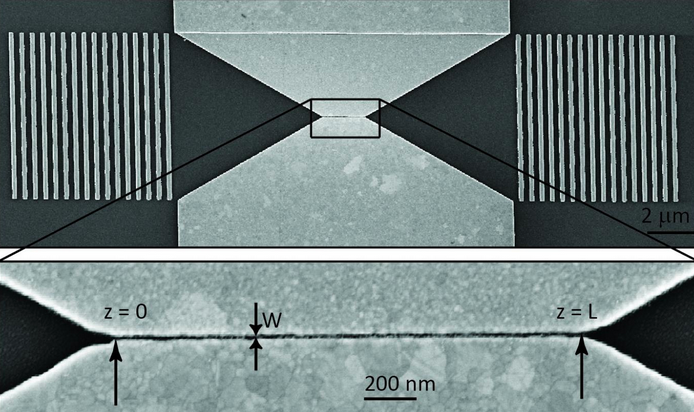Using light instead of electrons promises faster, smaller, more-efficient computers and smartphones
December 1, 2017

Trapped light for optical computation (credit: Imperial College London)
By forcing light to go through a smaller gap than ever before, a research team at Imperial College London has taken a step toward computers based on light instead of electrons.
Light would be preferable for computing because it can carry much-higher-density information, it’s much faster, and more efficient (generates little to no heat). But light beams don’t easily interact with one other. So information on high-speed fiber-optic cables (provided by your cable TV company, for example) currently has to be converted (via a modem or other device) into slower signals (electrons on wires or wireless signals) to allow for processing the data on devices such as computers and smartphones.

Electron-microscope image of an optical-computing nanofocusing device that is 25 nanometers wide and 2 micrometers long, using grating couplers (vertical lines) to interface with fiber-optic cables. (credit: Nielsen et al., 2017/Imperial College London)
To overcome that limitation, the researchers used metamaterials to squeeze light into a metal channel only 25 nanometers (billionths of a meter) wide, increasing its intensity and allowing photons to interact over the range of micrometers (millionths of meters) instead of centimeters.*
That means optical computation that previously required a centimeters-size device can now be realized on the micrometer (one millionth of a meter) scale, bringing optical processing into the size range of electronic transistors.
The results were published Thursday Nov. 30, 2017 in the journal Science.
* Normally, when two light beams cross each other, the individual photons do not interact or alter each other, as two electrons do when they meet. That means a long span of material is needed to gradually accumulate the effect and make it useful. Here, a “plasmonic nanofocusing” waveguide is used, strongly confining light within a nonlinear organic polymer.
Abstract of Giant nonlinear response at a plasmonic nanofocus drives efficient four-wave mixing
Efficient optical frequency mixing typically must accumulate over large interaction lengths because nonlinear responses in natural materials are inherently weak. This limits the efficiency of mixing processes owing to the requirement of phase matching. Here, we report efficient four-wave mixing (FWM) over micrometer-scale interaction lengths at telecommunications wavelengths on silicon. We used an integrated plasmonic gap waveguide that strongly confines light within a nonlinear organic polymer. The gap waveguide intensifies light by nanofocusing it to a mode cross-section of a few tens of nanometers, thus generating a nonlinear response so strong that efficient FWM accumulates over wavelength-scale distances. This technique opens up nonlinear optics to a regime of relaxed phase matching, with the possibility of compact, broadband, and efficient frequency mixing integrated with silicon photonics.